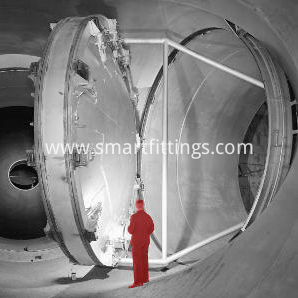
Privacy statement: Your privacy is very important to Us. Our company promises not to disclose your personal information to any external company with out your explicit permission.
 | Valve? What's the world's favorite form of transportation? The car? The bicycle? The jet airplane? If I had to hazard a guess, I'd pick none of these things. Instead, I'd opt for the humble pipeline. You might not notice pipes, but they're transporting vast amounts of fluid (liquid and gas) around the world quietly and efficiently, day in and day out. To work efficiently, pipes need a way of regulating how much fluid can pass through them; they also need a way of switching the flow off completely. That's the job that valves do: valves are like mechanical switches that can turn pipes on and off or raise or lower the amount of fluid flowing through them. Let's take a closer look at how they work! |
| What are valves? A valve is a mechanical device that blocks a pipe either partially or completely to change the amount of fluid that passes through it. When you turn on a faucet (tap) to brush your teeth, you're opening a valve that allows pressurized water to escape from a pipe. Similarly, when you flush the toilet, you open two valves: one that allows water to escape to empty the pan and another (called a ball valve or ballcock) that admits more water into the tank ready for the next flush. A large open butterfly valve in a wind tunnel with a man standing next to it. Photo: Some valves are gigantic. This 7.3-m (24-ft) diameter butterfly valve from a wind tunnel dwarfs the man standing next to it! Photo by courtesy NASA on the Commons. Valves regulate gases as well as liquids. If you have a gas cooktop (hob) on your stove, the controls that turn the gas up or down are valves. When you turn up the heat, you're opening a valve that allows more gas to flow in through the pipe. More gas burns with a bigger flame so you get more heat. Valves are pretty much guaranteed to be in any machine that use liquids or gases. There's a valve in your clothes washer that turns the water supply on or off each time the drum rinses out. There are also valves in the cylinders of your car engine, opening and closing several times a second to admit air and fuel and to allow burned exhaust gases to escape. It's not just machines that use valves. Your body has some pretty important valves inside your heart that allow it to pump blood to your lungs (where it picks up oxygen) and then around your body. |  |
| | How are valves made? Valves are usually made of metal or plastic and they have several different parts. The outer part is called the seat and it often has a solid metal outer casing and a soft inner rubber or plastic seal so the valve makes a closure that's absolutely tight. The inner part of the valve, which opens and closes, is called the body and fits into the seat when the valve is closed. There's also some form of mechanism for opening and closing the valve-either a manual lever or wheel (as in a faucet or a stop cock) or an automated mechanism (as in a car engine or steam engine). An open butterfly valve. Photo: This butterfly valve swivels open in the center to let air through a pipe. Photo by courtesy of NASA Glenn Research Center (NASA-GRC). It's often critically important for valves that are switched off to allow absolutely no escape of liquid or gas through a pipe to avoid accidents, explosions, pollution, or the loss of valuable chemicals (even a dripping faucet can be expensive if your water is metered). That's why the seal on a valve needs to be perfectly secure and a valve that's turned off must be tightly closed. Turning off a high-pressure flow of liquid or gas by obstructing it with a valve is physically hard work: in other words, you need to use a lot of force to do it. That's why some valves are operated by long levers (as in our top photo) or large wheels (as in the photo shown here). If really big valves require too much force for a human to supply, they're operated by hydraulic rams. bronze valve,broonze fittings,Yorkshire bronze fittings,Pegler bronze fittings. |
| Types of valves The many different types of valves all have different names. The most common ones are the butterfly, cock or plug, gate, globe, needle, poppet, and spool: 1.Ball: In a ball valve, a hollowed-out sphere (the ball) sits tightly inside a pipe, completely blocking the fluid flow. When you turn the handle, it makes the ball swivel through ninety degrees, allowing the fluid to flow through the middle of it. 2.Butterfly: A butterfly valve is a disk that sits in the middle of a pipe and swivels sideways (to admit fluid) or upright (to block the flow completely). 3.Cock or plug: In a cock or plug valve, the flow is blocked by a cone-shaped plug that moves aside when you turn a wheel or handle. 4.Gate or sluice: Gate valves open and close pipes by lowering metal gates across them. Most valves of this kind are designed to be either fully open or fully closed and may not function properly when they are only part-way open. Water supply pipes use valves like this. Globe: Water faucets (taps) are examples of globe valves. When you turn the handle, you screw a valve up or down and this allows pressurized water to flow up through a pipe and out through the spout below. Unlike a gate or sluice, a valve like this can be set to allow more or less fluid through it. 5.Needle: A needle valve uses a long, sliding needle to regulate fluid flow precisely in machines like car engine carburetors and central-heating systems. 6.Poppet: The valves in car engine cylinders are poppets. This type of valve is like a lid sitting on top of a pipe. Every so often, the lid lifts up to release or admit liquid or gas. 7.Spool: Spool valves regulate the flow of fluid in hydraulic systems. Valves like this slide back and forward to make fluid flow in either one direction or another around a circuit of pipes. | gunmetal fittings,End Feed Bronze Fittings,end feed gunmetal fittings,kembla bronze fittings,connex bronze fittings. |
 | How do safety valves works? Valves are often used to contain dangerous liquids or gases-maybe toxic chemicals, flammable petroleum, high-pressure steam, or compressed air-that mustn't be allowed to escape under any circumstances. In theory, a valve must be perfectly secure and, once closed, must never allow liquid or gas to get past it. In practice, that's not quite true. Sometimes it's better for a valve to fail, intentionally, to protect some other part of a system or machine. For example, if you have a steam engine powered by a water boiler in which steam is building up, but the pressure suddenly gets too high, you need a valve to blow open, let the steam escape, and release the pressure safely before the entire boiler explodes catastrophically. Valves that work in this way are called safety valves. They're designed to open automatically when the liquid or gas they contain reaches a certain pressure (though many systems and machines have safety valves that can be opened manually for the same purpose). |
Previous: The Process of Bronze Casting
Related Products List
Mobile Site


Privacy statement: Your privacy is very important to Us. Our company promises not to disclose your personal information to any external company with out your explicit permission.

Fill in more information so that we can get in touch with you faster
Privacy statement: Your privacy is very important to Us. Our company promises not to disclose your personal information to any external company with out your explicit permission.